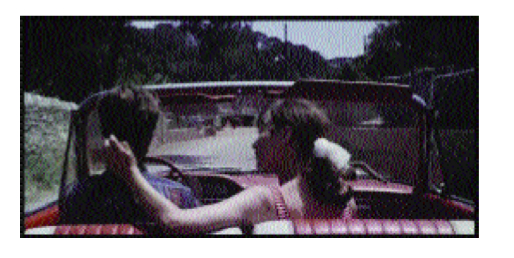A man is driving in the sun, and a woman is sitting next to him, and we see them from the backseat, so the landscape—in this case, dusty southern French provincial—moves all around us, conjuring an essential and sorcerous cinematic three-dimensionalism, a world (the car) within another world (southern France) within another world (the movie theater, or our living room), all trafficking along at their own pace and with their own agendas. It’s one of my favorite orts of movieness, this composition in transitu, as common as a thick slashing dab of Zinc White to conjure a glassware reflection. Though it is, in fact, rarely celebrated in the discourse that surrounds cinema, it’s as intoxicating as the moments in a pre-alarm-clock dream leading up to coitus with an otherwise unattainable woman, her hair backlit by morning light.
We’ve seen it a thousand times, haven’t we, this view from the backseat, and because films are so routinely constructed from just such stock visual ideas, we pay it little mind. (We know even better its less interesting inverse: the camera-on-the-hood frontal view, often at night with fake headlights passing over the back window.) But in this particular moving image, from Jean-Luc Godard’s Pierrot le fou (1965), our beloved Anna Karina’s long arm is resting over and across the seat, her hand lazily caressing Jean-Paul Belmondo’s neck as he drives, and they talk. The hand, the long nails on the neck flesh, the entrancing length of her arm, her fine, dark hair in the breeze, the capacious interior of the car (back when cars were made to live in, not just for sitting), the bright daylight around them, the indulgent traveling forward: this may well be my favorite Backseat Driving Shot—less narratively rich, perhaps, than several in Godard’s Band of Outsiders (1964), or the famous bank robbery in Lewis’s Gun Crazy (1950), and similar in its heavenly materials to scores of others. But this is the shot that has lodged in my brain wrinkles, the one that musters love for movies and driving and afternoons and Karina (whom I met, thirty-six years after she sat in that car, and kissed) and other women and the electric promise of youth from the dusty, fraught bowels of my underfunded, understaffed, middle-aged heart of memories.
We think we pay such fleeting visual proteins little attention, but in actuality it might be what we remember most from a movie: the close-up with the unconscious eyelash flutter, the dawn light falling on a wet street, the woman’s hand moving to her mouth in a moment of panic, the fuzzy back-projection image of a city block long forgotten, the naked Technicolor foolishness of...
You have reached your article limit
Sign up for a digital subscription and continue reading all new issues, plus our entire archives, for just $1.50/month.
Already a subscriber? Sign in





